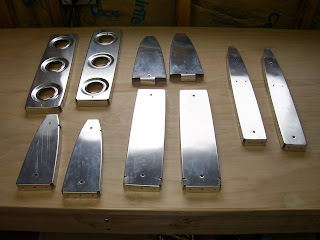Here's a shot of the left half of the HS, assembled for drilling. Even the pre-punched holes need to be "match-drilled" to their final size. This ensures a perect fit when the time comes for rivets.
 Here, I'm using a 12" #40 bit to get into a tough place. These long bits flex nicely as you drill, allowing you to get into tight spaces. I found that this technique was easier than using my angle drill.
Here, I'm using a 12" #40 bit to get into a tough place. These long bits flex nicely as you drill, allowing you to get into tight spaces. I found that this technique was easier than using my angle drill.Match-drilling the skin to a rib. The Cleco spring-clamps really help here :)
This kit is "pre-punched", which means that almost all the necessary holes are already there for you. The builder simply zips the parts together with clecoes. If the holes match, it must be right!
I have a lot of respect for the people who built aluminum planes before this feature was available.
 Here's the left side horiz. stabilizer with all holes drilled out, waiting for disassembly, deburring, dimpling and priming. Then it'll be time to rivet. See you next week!
Here's the left side horiz. stabilizer with all holes drilled out, waiting for disassembly, deburring, dimpling and priming. Then it'll be time to rivet. See you next week!






















